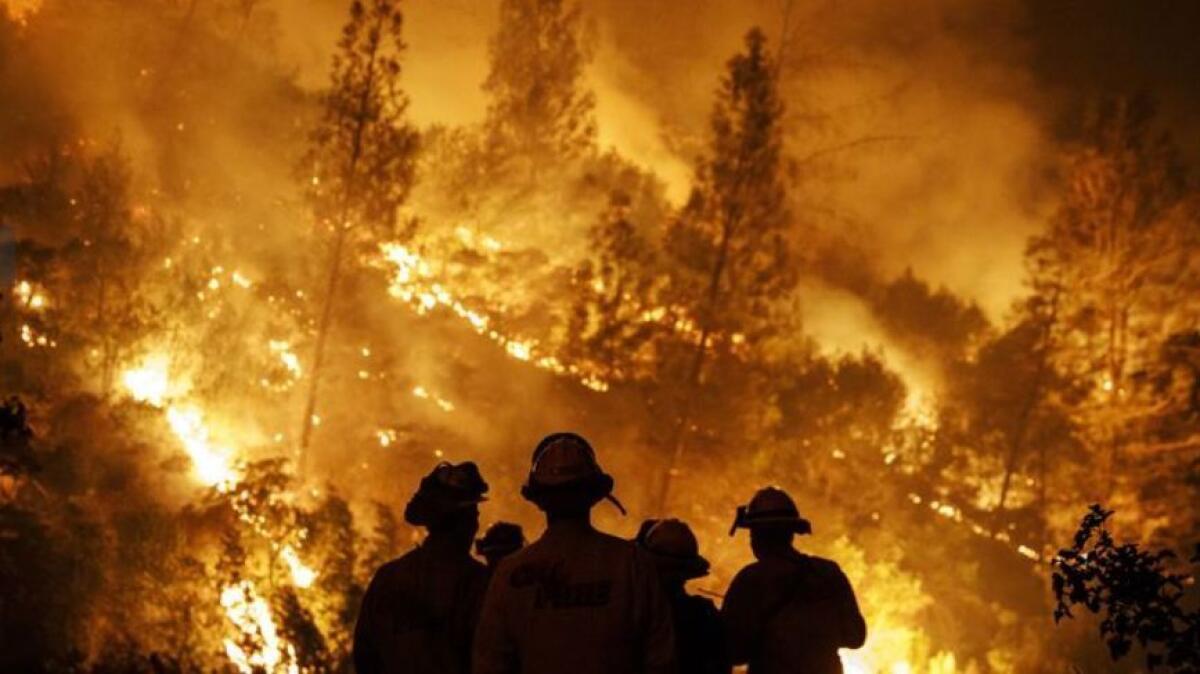Firefighters battling California’s largest fire hit by crippling data slowdown, slam Verizon’s tactics

A crew of firefighters from Silicon Valley had arrived in Lake County to help battle the largest blaze in California history when suddenly their mobile internet service slowed to a crawl.
Officials coordinating the firefighting effort inside the Santa Clara County Fire Department’s command vehicle faced email delays and challenges updating web-based documents with critical information about deployment, Capt. Bill Murphy said.
They quickly learned that their provider, Verizon Wireless, had throttled down the department’s connection to 1/200 or less than previous speeds because the agency had exceeded its data plan limit.
“It essentially rendered those very routine communications almost useless or completely ineffective,” Murphy said. “They were essentially dealing with dial-up type speeds.”
A Verizon representative told them the only way they could make the service faster immediately was to upgrade their plan at a higher cost. So they did, and service improved.
The breakdown occurred several weeks ago during the massive Mendocino Complex fire, which has destroyed more than 150 homes and killed one firefighter. But the incident only became public this week, sparking widespread outrage both from fire officials and the public.
Santa Clara County Fire Chief Anthony Bowden chronicled the incident in an addendum to a federal lawsuit filed Monday by 21 states — including California — and the District of Columbia seeking to overturn the Federal Communications Commission’s repeal of net neutrality rules.
The repeal, which went into effect in June, scrapped Obama-era regulations that, among other things, prevented internet service providers from blocking content they didn’t like or charging providers more for speeding up delivery of certain content.
Verizon spokeswoman Heidi Flato wrote in a statement Wednesday that the situation with the Santa Clara County Fire Department was a “customer support mistake” and “has nothing to do with net neutrality or the current proceeding in court.”
“This customer purchased a government contract plan for a high-speed wireless data allotment at a set monthly cost,” she wrote. “Under this plan, users get an unlimited amount of data but speeds are reduced when they exceed their allotment until the next billing cycle.”
However, Flato wrote that the company has a practice to remove data speed restrictions for emergency responders — regardless of the plan they have chosen — in emergency situations.
“In this situation, we should have lifted the speed restriction when our customer reached out to us,” she said. “We are reviewing the situation and will fix any issues going forward.”
Murphy said officials felt compelled to join in the lawsuit in hopes of ensuring that reduced data speeds won’t affect the public’s access to information such as evacuation routes and fire maps disseminated online during emergencies.
“If the public were to experience the same level of throttling that we experienced, their ability to access basic information we’re trying to get them would be significantly reduced,” he said.
The necessity of prompt communication during disasters was highlighted during the 2017 wine country fires in Northern California; officials have debated whether more could have been done to give residents earlier warnings before the fires swept in, ultimately killing 44 people and destroying more than 10,000 homes.
In the wake of that disaster and the deadly flood in Montecito that followed the Thomas fire, there has been much discussion about better targeting emergency alerts and evacuation orders to the cellphones of people living in endangered areas. Some of the alerts for those disasters only reached a fraction of those who were in evacuation zones.
For the firefighters battling the Mendocino Complex, Bowden wrote that data-slowing affected a department command vehicle that acts as a mobile emergency operations center. The van requires “near-real-time information exchange” to coordinate resources and staff during emergencies, he wrote.
“Dated or stale information regarding the availability or need for resources can slow response times and render them far less effective,” he wrote. “Resources could be deployed to the wrong fire, the wrong part of the fire, or fail to be deployed at all. Even small delays in response translate into devastating effects, including loss of property, and, in some cases, loss of life.”
The Santa Clara County department now uses FirstNet, a service that provides wireless network service to public safety agencies, as a supplement to Verizon to avoid future issues, Murphy said.
Emails between fire officials and Verizon representatives filed in court show that the department has been having issues with data throttling since December 2017. Fire crews noticed the problem again in June, as they fought the Pawnee fire, which burned 15,185 acres in Lake County. During that incident, Verizon suggested a $2-a-month upgrade to the fire department’s plan to restore data speeds.
Data speeds continued to be an issue as Santa Clara County firefighters deployed to the Mendocino Complex fire, which began July 27 and had charred 410,482 acres in Mendocino, Lake, Colusa and Glenn counties as of Wednesday.
“Please work with us,” a fire official wrote to Verizon on July 30. “All we need is a plan that does not offer throttling or caps of any kind.”
In response, Verizon suggested the department upgrade to a $99.99 per month plan, which would have more than doubled its bill, to remove the data throttling. Before the department subscribed to the new plan, county fire personnel used other agencies’ internet service and their personal devices to deploy fire resources, Bowden wrote.
“In light of our experience, county fire believes it is likely that Verizon will continue to use the exigent nature of public safety emergencies and catastrophic events to coerce public agencies into higher cost plans, ultimately paying significantly more for mission critical service, even if that means risking harm to public safety during negotiations,” he wrote.
Katharine Trendacosta, a policy analyst with the nonprofit Electronic Frontier Foundation, said the department’s experience “is an example of why actions like this are so dangerous and why we need to pay attention to how we’re getting our internet.”
Concerns over the incident were raised on Wednesday by members of the state Assembly Communications and Conveyance Committee, which advanced far-reaching legislation to reinstate net neutrality protections in California. If it receives full legislative approval, Senate Bill 822 would bar internet service providers from blocking, speeding up or slowing down websites and video, as well as charging websites fees for fast lanes.
Assemblyman Freddie Rodriguez (D-Pomona) said he was troubled by what happened to the Santa Clara County firefighters.
“If it is happening to them… [while] doing their job and protecting our people and saving lives, I am having a problem with that,” said Rodriguez.
Times Staff Writer Jasmine Ulloa in Sacramento contributed to this report.
More to Read
Sign up for Essential California
The most important California stories and recommendations in your inbox every morning.
You may occasionally receive promotional content from the Los Angeles Times.











